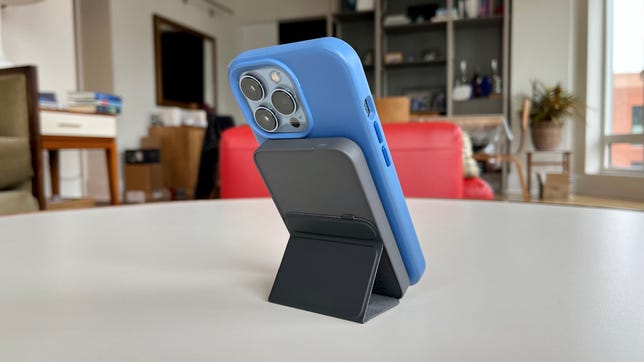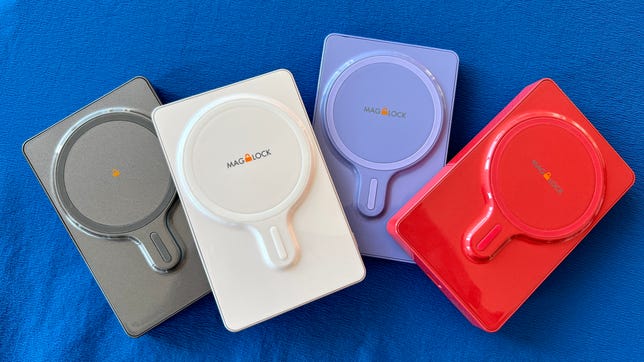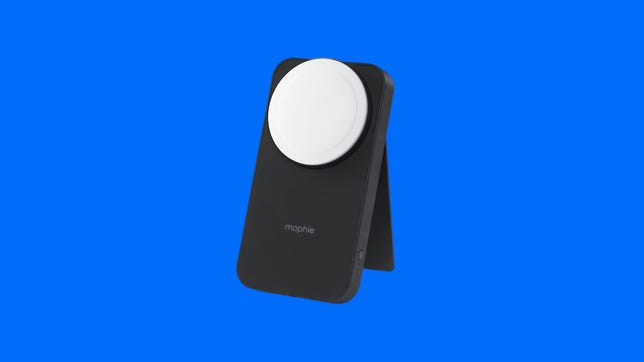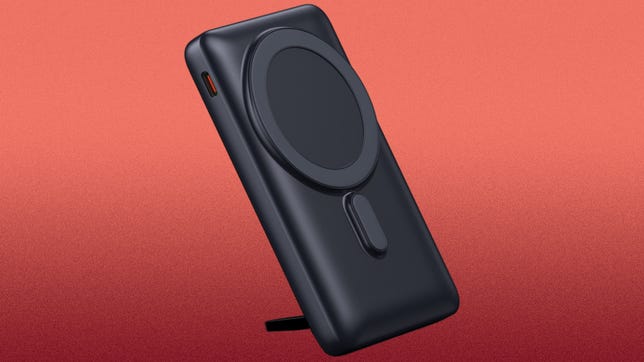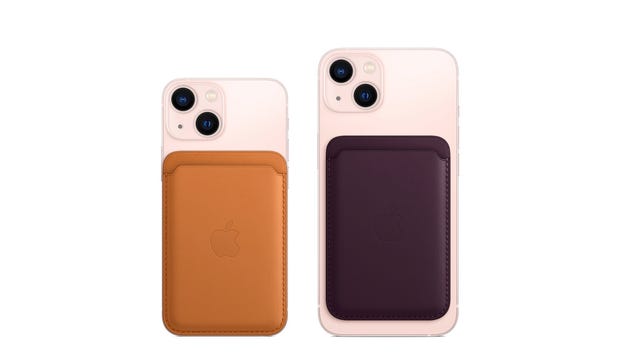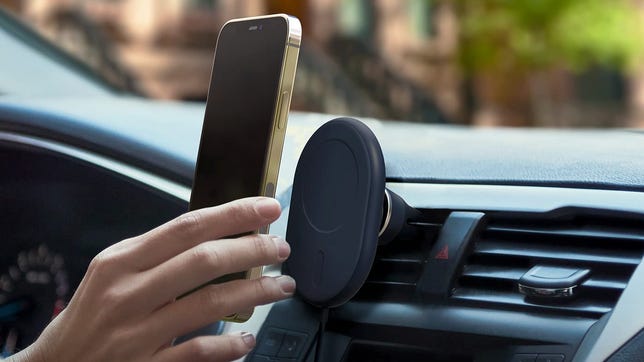Technologies
Best MagSafe Accessories for iPhone in 2023
From stands to wallets to car mounts and wireless battery chargers, here are the best MagSafe accessories for iPhone.

The MagSafe technology built into Apple’s latest iPhones is not only designed for wireless charging but a wide range of new magnetic accessories, the best of which we’ve rounded up here. They include wallets, power banks, stands, kickstands, car mounts and other devices that adhere to the back of your iPhone or MagSafe-compatible iPhone case.
Some «MagSafe» accessories are official, Apple-licensed products while others aren’t. The main difference is that accessories that aren’t Apple-certified won’t be able to charge at the highest speeds (up to 15 watts). But in a lot of cases, the lack of certification won’t change how well the product performs, though some non-Apple-certified MagSafe-compatible accessories sometimes lack strong enough magnets.
Here’s a look at my current favorite MagSafe accessories. Note that I’ve personally used all of the products listed below. We’ll update this list as we discover new top accessories.
Read more: Best iPhone 14 Cases So Far
Magnetic wireless battery chargers
What’s cool about Anker’s 622 magnetic battery is that it’s a wireless battery that has an integrated magnetic flap that converts into a stand. You won’t get fast wireless charging from this 5,000-mAh battery (it charges at up to 7.5 watts) but it’s slim and easy to carry around.
It charges via USB-C and if you use a USB-C to Lighting to charge your iPhone, it will charge at a faster rate of 12 watts. That’s not as fast as what a 20-watt USB-C power adapter can deliver, but it’s faster than 7.5 watts.
The Baseus Magnetic Mini Wireless Portable Charger is a compact 6000-mAh wireless power bank that sticks to the back of MagSafe-enabled iPhones (or MagSafe-enabled iPhone cases) and charges your iPhone at 7.5W. If you’re looking for faster charging, you can plug a USB-C to Lightning cable into the battery and get 20W charging speeds. It also offers pass-through charging (you can charge the battery while charging your phone).
The battery is similar in size to many 5000-mAh batteries and also costs less. That 6000-mAh capacity will get you close to a full charge with most iPhones, though it may fall a bit short for iPhone Max models.
You don’t want your phone to go dead on the mountain so it’s always good to pack a battery pack.
MyCharge calls its new line of magnetic power banks Superhero MagLock, implying that they’re real saviors. I was impressed by their design. Not only do the batteries, which come in various capacities, have strong magnets and stick really well to the back of your iPhone 12, 13 or 14, but they have raised coils, which are supposed to help with reducing heat levels while charging. It does seem to work.
The 3,000-mAh battery is lightweight and slim and is nice to have around for some emergency charging. However, it won’t get you a full charge, so you’ll probably want to step up to one of the higher-capacity options like the 6,000-mAh model, which retails for $60, but you can currently grab for 30% off with the on-page instant coupon. The 9,000-mAh version is beefy and feels like your phone is attached to a small brick — the battery and phone do fit in your hand nicely, but the combo certainly isn’t pocket-friendly.
All the MagLock batteries charge Qi-enabled iPhones at 5 watts, although you can get faster charging if you go wired and use a USB-C to Lightning cable. I also liked how there’s a chime when the charging starts and your phone tells you how much juice is left in the battery pack (it’s tied into iOS 15). You can wirelessly charge Android devices as well but the MagLock won’t stick unless you have a metal ring on the back of your phone’s case (stick-on rings are available).
The SuperHero MagLock is available in a few colors and has a glossy finish. It’s currently the best designed magnetic power bank — better even than Apple’s.
Mophie’s Powerstation Wireless Stand with MagSafe is currently only sold through Apple and Zagg, Mophie’s parent company. It’s not cheap, but it is a versatile 10,000-mAh battery battery with both a stand and MagSafe charger built in, and also has a threaded tripod mount at the bottom.
Since this is an official MagSafe charger, the battery does charge at 15 watts, making this among the fastest wireless external battery chargers out there and will also charge the AirPods 3 and AirPods Pro models with MagSafe. If you use a USB-C-to-Lighting cable (not included) with it, you can charge at 20-watt speeds. You can also charge two devices at the same time.
If you’re looking for a bigger portable battery that charges your phone wirelessly, the Baseus Magnetic Wireless Power Bank is an excellent option. It houses a 10,000-mAh battery that can charge an iPhone 14 around two times — but it’s still somewhat compact.
The magnet is strong, and I also liked that it has an integrated flip-out kickstand, so it converts into a stand. There’s also an LED battery life indicator on back of the battery that tells you exactly how much juice the battery has left (you see the actual percentage). The Baseus Magnetic Wireless Power Bank is available in three color options with the black version currently costing a few bucks less.
The RapidX Boosta magnetic wireless portable charger comes in a variety of colors and is about $10 less than some magnetic 5,000-mAh battery power banks. This isn’t an official Apple MagSafe accessory, but it magnetically adheres to the back of your MagSafe-enabled iPhone or MagSafe case — yes, its magnet is strong — and can also be used with other phones that support wireless charging.
Wireless charging speeds are limited to 7.5 watts for iPhones, but if you need a faster charge, you can connect a USB-C to Lightning cable to bump the speed up to 10 watts. Just note that it will fall a little short of a full charge for a Pro Max, so you may want to upgrade to a larger power bank if you’re using that model.
Magnetic folding stands/wallets
Clckr’s new, trimmer Stand and Grip is one of my favorite MagSafe accessories. The accessory really sticks to the back of your MagSafe-enabled phone or MagSafe-enabled case and not only makes it easier to hold up your phone but when converted into a kickstand, it props up your device nicely in portrait or landscape mode for video calls or video watching.
This new version is lighter than the original and available in several colors. It’s one of the best MagSafe stands out there.
This accessory from Moft not only acts as a magnetic wallet that adheres to the back of your MagSafe-enabled iPhone (or case), but it converts into a stand that can be used to prop up your phone horizontally or vertically. The wallet fits a couple of credit cards (you can stretch it a bit to get three in there) and the accessory has a fairly strong magnet, so it stays on your phone pretty well.
I’m showing it in light blue but it’s available in several colors. You can also buy this as a bundle for $60 with Moft’s MagSafe case, which is a nice case.
Zagg’s Gear4 Ring Snap 360 is is a ring accessory that converts into a stand. It not only feels solid but looks sleek and has a strong magnet that allows the accessory to stick securely to the back of your iPhone or MagSafe-enabled case. The stand works better for propping up your phone horizontally (in landscape mode) but can also prop it up vertically at about a 45-degree angle. It’s available in two colors, but the rose gold model is currently available only on Zagg’s website.
The Anker 610 magnetic phone grip is one of the more affordable MagSafe accessories. It has a strong magnet and you can use the retractable ring to hold your phone securely in your hand or as a kickstand. It allows you to prop up your phone horizontally but not vertically. Some other MagSafe stands do both.
If you’re a PopSockets fan, you have a couple of MagSafe options. There’s the more standard PopGrip ($30) and the PopWallet Plus for MagSafe ($40), which combines a magnetic wallet that stores a few credit cards and a PopGrip that gives you a grip and kickstand option.
Available in multiple color options, this simple, lightweight flip-out kickstand has a strong magnet and takes up minimal space on the back of your phone (it works better for propping your phone up horizontally).
Apple’s official MagSafe wallet is more expensive than a lot of third-party magnetic wallets, but the one thing it has that the other ones don’t is compatibility with Apple’s Find My network. But don’t expect to track it down like an AirTag: It really just signals if and when it becomes detached. It’s available in five colors.
Magnetic charging stands
Belkin’s MagSafe Wireless Charger with Kickstand is essentially a better version of Apple’s own wireless MagSafe charger because it integrates a flip-out kickstand, allowing you to watch videos on your iPhone as you charge (or play games if you have a wireless game controller).
It does charge at up to 15 watts and comes in three color options: black, white and blue. Alas, no power adapter is included (the cable is integrated into the charging puck).
The Anker 637 has a magnetic charging pad on one side and seven charging ports on the back: two USB-C, two USB-A and three standard AC outlets. The USB-C ports deliver up to a 65-watt charge when charging one device — or 45- and 20-watt if charging two devices simultaneously. So yes, you can use it to charge most laptops that charge via USB-C.
For MagSafe-enabled iPhones, the wireless charging pad charges at 7.5 watts. You can only charge Android phones if you stick a metal ring accessory (sold separately) on the back of your device and place it in the right spot. You can also save $30 right now by activating the instant coupon on the product page.
Anker’s 633 2-in-1 MagGo charging stand has more components than you might think at first glance. Not only is it a charging stand that also has a spot to charge your AirPods (or any earbuds with a wireless charging case and even a second phone), but the wireless charging pad is actually a 5,000-mAh portable battery, which is why I put it in the wireless battery section.
Since this isn’t an Apple blessed MagSafe charger, it only charges at up to 7.5 watts (not 15). It comes in black, white or light blue.
Read our first take of Anker 633 2-in-1 MagGo Charging Stand.
The Boost Charge Pro 3-in-1 is an Apple-certified MagSafe accessory so it offers fast (15-watt) wireless charging for your MagSafe-enabled iPhone as well the Apple Watch.
It includes a 40-watt adapter and I charged an iPhone 13 Pro, the third-generation AirPods and Watch Series 7 at the same time. Like the Boost Charge Watch fast-charger, the adjustable Watch module accommodates any Apple Watch case size in either flat or in nightstand mode. You can also charge a second phone on the AirPods slot, but you don’t get fast-charging there — it only offers 5-watt charging.
This is certainly a nice charging station for Apple devices. It has a sleek, elegant design, with a soft-to-the-touch silicone finish. My only gripe? That finish is a dust magnet and I had to wipe it down with an alcohol towelette to remove any dust particles before I photographed it. The black shows more dust so I’d recommend getting the white version (of both chargers) rather than the black.
Read our first take of Belkin Boost Pro 3-in-1 Charging Pad with MagSafe.
Magnetic car mounts and chargers
iOttie offers this MagSafe-compatible wireless car charger with a car vent mount. It has a strong magnet, so your iPhone stays on the mount, and it also has an integrated USB-C cable and cigarette-lighter power adapter so you’re ready to start charging out of the box. Note that the iPhone’s «fast» charging caps out at 7.5 watts.
Spigen’s OneTap magnetic car mount comes in a few different versions, including an air vent and dashboard versions. This version is just a magnetic mount, not a wireless charger. You have to step up to the Spigen OneTap Pro ($40) to get wireless charging.
This model features a telescopic arm and fairly strong magnet. However, it’s not quite as strong as the one in Belkin’s car mount (see below). While it’s quite affordable at around $30, there’s no cigarette lighter power adapter included (a USB-C cable is, however).
Belkin’s Car Vent Mount Pro with MagSafe technically isn’t a charger. It’s just a certified MagSafe vent mount. Belkin also has a wireless charging version of this (it costs $40 without the car charger, $60 with it), but you’d have to connect a cable to it anyway for charging. The advantage of a wireless version would be that unlike with this vent mount, you wouldn’t have to plug a cable into your phone every time you want to charge it. I have a USB-C-to-LIghtning cable set up in the car for fast charging, but I don’t love the extra step of having to plug in the cable each time I want to charge the phone.
All that said, what sets this Belkin apart from other generic, non-MagSafe-certified mounts that look similar (and some even offer wireless charging), is that the Belkin has a very strong magnet while many of these other vent mounts don’t. If you have a MagSafe case on your phone, or just a naked newer iPhone model, the phone really sticks to the mount. The clip also keeps the mount securely in your vent and you can rotate the mount from portrait to landscape mode as needed.
Magnetic mounts for laptops and monitors
You can now turn your iPhone into a webcam using the Continuity Camera features in the latest version of MacOS. What’s cool about the Belkin iPhone Mount with MagSafe for Mac Notebooks is that you can use it as a kickstand to prop your iPhone up in landscape mode. And you can use the flip side of the mount to attach your phone to the top of your MacBook in landscape or portrait mode for webcam use.
Check out our hands-on review and video of the Belkin iPhone Mount for MagSafe for Mac Notebooks.
STM’s MagArm is designed to stick to the back of your laptop or computer monitor with the help of an integrated suction cup. Some people have complained that the suction cup doesn’t adhere securely enough, but I attached the MagArm to both a monitor and laptop and it adhered just fine if you follow the instructions correctly. I used it with an iPhone 14 Pro, which is a pretty heavy phone, but I didn’t use it with an iPhone 14 Max Pro or Max Plus.
You can adjust the mount so it sits horizontally (on the side) or vertically (on top) of your laptop or monitor. And what’s nice about it, if you own Apple’s wireless MagSafe charging puck, there’s a dock for it built into the mount so you can keep your phone charged (you could also just plug your phone into a a wired charger).
While the the MagArm is bigger and bulkier than some laptop MagSafe mounts, it’s sturdily constructed. You can peel the suction cup off your laptop (it doesn’t leave a mark) and you can remount it when you need to use it again.
Magnetic photo and video accessories
The Joby Beamo LED Ring Light for MagSafe is a nifty MagSafe ring light that adheres magnetically to the back of your iPhone but can be used with the front selfie camera as well as shots using the rear camera. Equipped with an integrated rechargeable battery that charges via USB-C, it’s well designed and uses a «flattering soft» 5600K Daylight color temperature with 4 levels of brightness you can toggle through.
It’s also worth noting that it has a built-in mirror for checking yourself out before you shoot.
Joby makes bendable tripods for cameras and smartphones and its products are a staple of vloggers and other content creators. Sometimes it’s a little cumbersome to get your phone out of their clamping mounts, which is what’s appealing about the company’s new MagSafe options. You can simply stick your phone to the mount; it adheres magnetically.
My iPhone 13 Pro stuck pretty securely to the GripTight mount. I was testing it with an Otterbox MagSafe-enabled case, so I wasn’t really worried about the phone getting jostled and falling off the mount. But if you want a more secure fit, you have the option of using the «hybrid» clamp to really lock your phone onto the mount. The clamp works in both vertical and horizontal modes and when you’re going the magnetic route only, you can easily swivel your phone into a horizontal or vertical position.
Joby is currently selling three GripTight for MagSafe accessories. There’s a simple wall-mount option, a GripTight Mount for MagSafe that can be added to any GorillaPod (or tripod for that matter), as well as a bundle that includes a GorillaPod and GripTight Mount (arms for the GorillaPod are sold separately). All three new MagSafe options are also compatible with Joby’s Wavo Mobile, Beamo Mini and RangePod accessories.
Belkin’s magnetic phone mount with face tracking is designed for folks who shoot their own selfie videos for TikTok, Instagram and other social media platforms with a MagSafe-enabled iPhone. (The device has a companion iOS app but not an Android app.) There are competing products out there like the Pivo Pod Lite ($70), but this is MagSafe-enabled so all you have to do is stick your phone on the mount — you can simply turn your phone to place it in landscape or portrait mode. The pedestal automatically turns as your phone follows your face while you’re shooting yourself.
To be clear, this is not for FaceTime or WhatsApp or WeChat video calls. It doesn’t have to be plugged so it’s easy to move around the room and place wherever you want. However, it’s not equipped with rechargeable batteries. It’s powered by three AA batteries that do give the pedestal some added weight for stability.
Moment makes a few different photography-oriented MagSafe accessories, including a couple of tripod mounts. With the Pro tripod mount you can choose to just use the magnets or lock your phone in for added security. This may not work as well with the larger Pro Max model, but the standard iPhone 14 and 14 Pro are lighter and are less likely to become detached (magnets are only so strong).
Here are a few things to keep in mind when buying MagSafe-related accessories, particularly so-called MagSafe charging products:
- A true MagSafe wireless charger will get you the potential for the fastest wireless charging rate (up to 15 watts instead 7.5 watts or 10 watts that some chargers deliver) on iPhones.
- Official MagSafe products — those blessed by Apple — include a Made for MagSafe badge on the box. However, plenty of other manufacturers have created magnetic wireless chargers that look and feel like MagSafe accessories. These MagSafe technology copycat devices are also far more affordable than the official MagSafe offerings, but here’s the catch: they offer less powerful charging (limited to 7.5 watts). We’ve included these non-official products in this list, but know that they’ll charge only half as fast (for iPhones), even if they are capable of wirelessly charging certain Android smartphones at up to 15 watts (those that support 15-watt fast wireless charging).
- Do not expect a MagSafe or magnetic accessory to stick to a non-MagSafe case. MagSafe accessories should be used directly with a naked MagSafe-enabled iPhone or MagSafe-enabled case. Alternatively, you can add a stick-on metal ring accessory to the back of a non MagSafe phone or case. However, it’s best to use a MagSafe-enabled case with MagSafe and other magnetic accessories.
- To get that maximum power, you’ll need a 20-watt USB-C PD charger — ideally one that is Power Delivery 3.0-certified. (The iPhone 13, iPhone 13 Pro, iPhone 13 Pro Max and iPhone 13 Mini include a USB-C to Lightning cable in the box, but not the charger.) Some companies offer bundles that include a MagSafe wireless charging puck with a USB-C power adapter while others, like Apple, sell the puck and power adapter separately.
- Most of the MagSafe chargers (aftermarket and MagSafe-certified) will charge other Qi-compatible devices, like select older iPhones and Android phones. You just won’t get the magnetic adhesion.
- If you need to also get a charger, our list of best USB-C chargers has plenty of options. That will, of course, work for wired charging, too — which will always be faster than MagSafe or other wireless charging options.
Technologies
Today’s NYT Connections Hints, Answers and Help for Dec. 24, #927
Here are some hints and the answers for the NYT Connections puzzle for Dec. 24 #927
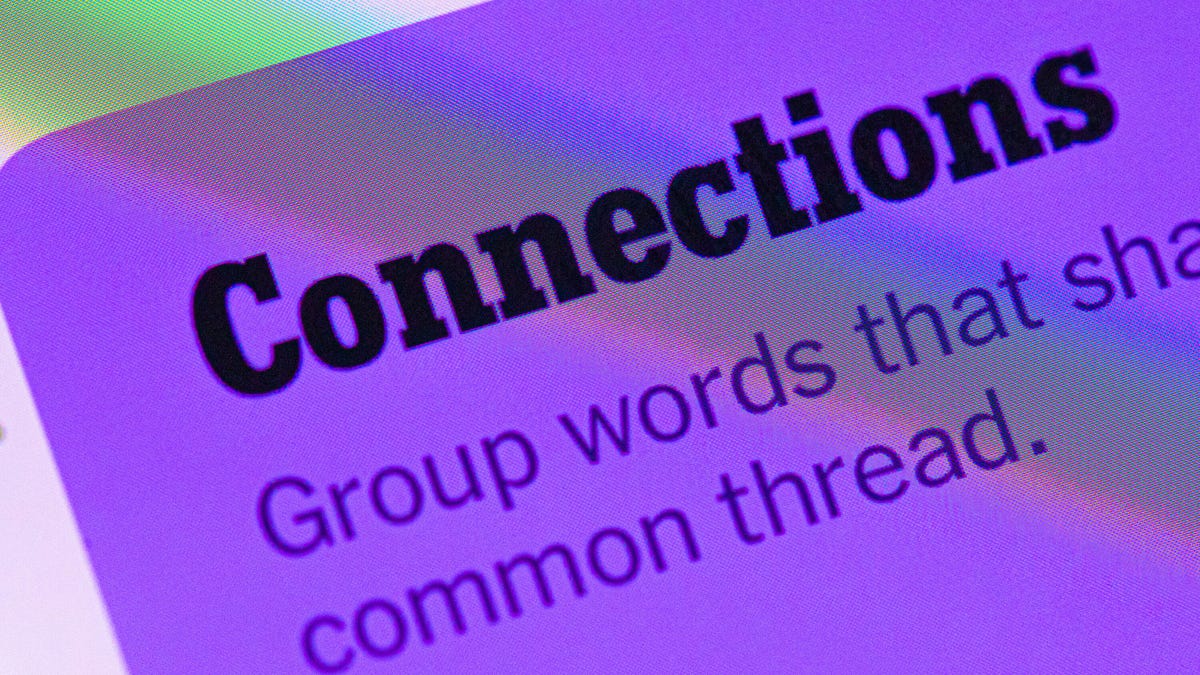
Looking for the most recent Connections answers? Click here for today’s Connections hints, as well as our daily answers and hints for The New York Times Mini Crossword, Wordle, Connections: Sports Edition and Strands puzzles.
Today’s NYT Connections puzzle is kind of tough. Ooh, that purple category! Once again, you’ll need to look inside words for hidden words. Read on for clues and today’s Connections answers.
The Times has a Connections Bot, like the one for Wordle. Go there after you play to receive a numeric score and to have the program analyze your answers. Players who are registered with the Times Games section can now nerd out by following their progress, including the number of puzzles completed, win rate, number of times they nabbed a perfect score and their win streak.
Read more: Hints, Tips and Strategies to Help You Win at NYT Connections Every Time
Hints for today’s Connections groups
Here are four hints for the groupings in today’s Connections puzzle, ranked from the easiest yellow group to the tough (and sometimes bizarre) purple group.
Yellow group hint: Cash out.
Green group hint: Chomp
Blue group hint: Walleye and salmon.
Purple group hint: Make a musical sound, with a twist.
Answers for today’s Connections groups
Yellow group: Slang for money.
Green group: Masticate.
Blue group: Fish.
Purple group: Ways to vocalize musically plus a letter.
Read more: Wordle Cheat Sheet: Here Are the Most Popular Letters Used in English Words
What are today’s Connections answers?
The yellow words in today’s Connections
The theme is slang for money. The four answers are bacon, bread, cheese and paper.
The green words in today’s Connections
The theme is masticate. The four answers are bite, champ, chew and munch.
The blue words in today’s Connections
The theme is fish. The four answers are char, pollock, sole and tang.
The purple words in today’s Connections
The theme is ways to vocalize musically plus a letter. The four answers are hump (hum), rapt (rap), singe (sing) and whistler (whistle).
Don’t miss any of our unbiased tech content and lab-based reviews. Add CNET as a preferred Google source.
Toughest Connections puzzles
We’ve made a note of some of the toughest Connections puzzles so far. Maybe they’ll help you see patterns in future puzzles.
#5: Included «things you can set,» such as mood, record, table and volleyball.
#4: Included «one in a dozen,» such as egg, juror, month and rose.
#3: Included «streets on screen,» such as Elm, Fear, Jump and Sesame.
#2: Included «power ___» such as nap, plant, Ranger and trip.
#1: Included «things that can run,» such as candidate, faucet, mascara and nose.
Technologies
Today’s NYT Mini Crossword Answers for Wednesday, Dec. 24
Here are the answers for The New York Times Mini Crossword for Dec. 24.
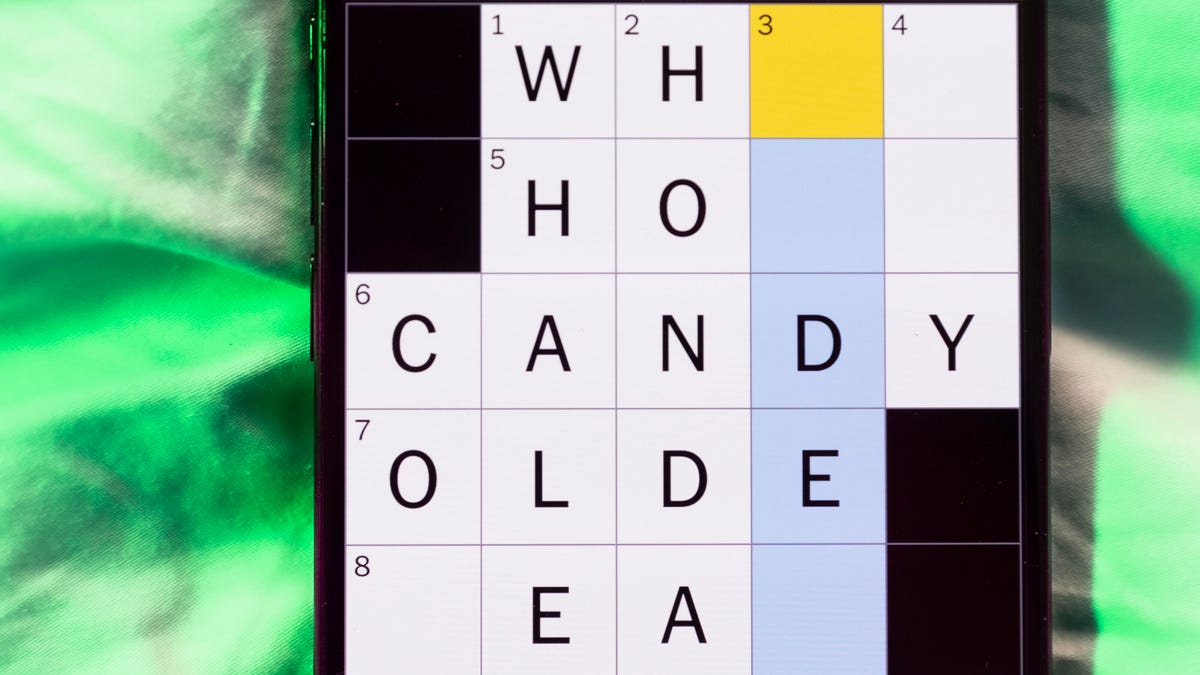
Looking for the most recent Mini Crossword answer? Click here for today’s Mini Crossword hints, as well as our daily answers and hints for The New York Times Wordle, Strands, Connections and Connections: Sports Edition puzzles.
Need some help with today’s Mini Crossword? I’m Irish-American, but yet 6-Down, which involves Ireland, stumped me at first. Read on for all the answers.. And if you could use some hints and guidance for daily solving, check out our Mini Crossword tips.
If you’re looking for today’s Wordle, Connections, Connections: Sports Edition and Strands answers, you can visit CNET’s NYT puzzle hints page.
Read more: Tips and Tricks for Solving The New York Times Mini Crossword
Let’s get to those Mini Crossword clues and answers.
Mini across clues and answers
1A clue: Wordle or Boggle
Answer: GAME
5A clue: Big Newton
Answer: ISAAC
7A clue: Specialized vocabulary
Answer: LINGO
8A clue: «See you in a bit!»
Answer: LATER
9A clue: Tone of many internet comments
Answer: SNARK
Mini down clues and answers
1D clue: Sharks use them to breathe
Answer: GILLS
2D clue: From Singapore or South Korea, say
Answer: ASIAN
3D clue: Large ocean ray
Answer: MANTA
4D clue: ___ beaver
Answer: EAGER
6D clue: Second-largest city in the Republic of Ireland, after Dublin
Answer: CORK
Don’t miss any of our unbiased tech content and lab-based reviews. Add CNET as a preferred Google source.
Technologies
Quadrantids Is a Short but Sweet Meteor Shower Just After New Year’s. How to See It
This meteor shower has one of the most active peaks, but it doesn’t last for very long.

The Quadrantids has the potential to be one of the most active meteor showers of the year, and skygazers won’t have long to wait to see it. The annual shower is predicted to reach maximum intensity on Jan. 3. And with a display that can rival Perseids, Quadrantids could be worth braving the cold to see it.
Don’t miss any of our unbiased tech content and lab-based reviews. Add CNET as a preferred Google source.
The show officially begins on Dec. 28 and lasts until Jan. 12, according to the American Meteor Society. Quadrantids is scheduled to peak on Jan. 2-3, when it may produce upwards of 125 meteors per hour. This matches Perseids and other larger meteor showers on a per-hour rate, but Quadrantids also has one of the shortest peaks at just 6 hours, so it rarely produces as many meteors overall as the other big ones.
The meteor shower comes to Earth courtesy of the 2003 EH1 asteroid, which is notable because most meteor showers are fed from comets, not asteroids. Per NASA, 2003 EH1 is a near-Earth asteroid that orbits the sun once every five and a half years. Science posits that 2003 EH1 was a comet in a past life, but too many trips around the sun stripped it of its ice, leaving only its rocky core. The Earth runs through EH1’s orbital debris every January, which results in the Quadrantids meteor shower.
How and where to see Quadrantids
Quadrantids is named for the constellation where its meteors appear to originate, a point known as the radiant. This presents another oddity, as the shower originates from the constellation Quadrans Muralis. This constellation ceased to be recognized as an official constellation in the 1920s and isn’t available on most publicly accessible sky maps.
For the modern skygazer, you’ll instead need to find the Bootes and Draco constellations, both of which contain stars that were once a part of the Quadrans Muralis. Draco will be easier to find after sunset on the evening of Jan. 2, and will be just above the horizon in the northern sky. Bootes orbits around Draco, but will remain under the horizon until just after 1 a.m. local time in the northeastern sky. From that point forward, both will sit in the northeastern part of the sky until sunrise. You’ll want to point your chair in that direction and stay there to see meteors.
As the American Meteor Society notes, Quadrantids has a short but active peak, lasting around 6 hours. The peak is expected to start around 4 p.m. ET and last well into the evening. NASA predicts the meteor shower to start one day later on Jan. 3-4, so if you don’t see any on the evening of Jan. 2, try again on Jan. 3.
To get the best results, the standard space viewing tips apply. You’ll want to get as far away from the city and suburbs as possible to reduce light pollution. Since it’ll be so cold outside, dress warmly and abstain from alcoholic beverages, as they can affect your body temperature. You won’t need any binoculars or telescopes, and the reduced field of view may actually impact your ability to see meteors.
The bad news is that either way, the Quadrantids meteor shower coincides almost perfectly with January’s Wolf Moon, which also happens to be a supermoon. This will introduce quite a lot of light pollution, which will likely drown out all but the brightest meteors. So, while it may have a peak of over 100 meteors per hour, both NASA and the AMS agree that the more realistic expectation is 10 or so bright meteors per hour.
-

 Technologies3 года ago
Technologies3 года agoTech Companies Need to Be Held Accountable for Security, Experts Say
-

 Technologies3 года ago
Technologies3 года agoBest Handheld Game Console in 2023
-

 Technologies3 года ago
Technologies3 года agoTighten Up Your VR Game With the Best Head Straps for Quest 2
-

 Technologies4 года ago
Technologies4 года agoBlack Friday 2021: The best deals on TVs, headphones, kitchenware, and more
-

 Technologies4 года ago
Technologies4 года agoVerum, Wickr and Threema: next generation secured messengers
-

 Technologies4 года ago
Technologies4 года agoGoogle to require vaccinations as Silicon Valley rethinks return-to-office policies
-

 Technologies4 года ago
Technologies4 года agoOlivia Harlan Dekker for Verum Messenger
-

 Technologies4 года ago
Technologies4 года agoiPhone 13 event: How to watch Apple’s big announcement tomorrow

